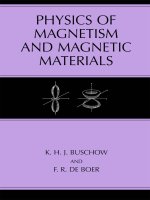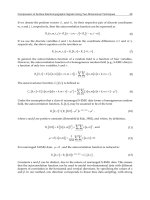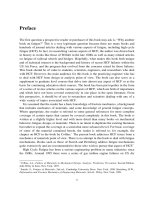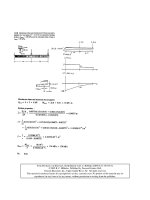Physics of Magnetism Magnetic Materials 2011 Part 2 doc
Bạn đang xem bản rút gọn của tài liệu. Xem và tải ngay bản đầy đủ của tài liệu tại đây (685.31 KB, 17 trang )
13
SECTION 3.2. THE CURIE LAW
Substitution of this result into Eq. (3.1.5) leads to
Since sinh one obtains
After carrying out the differentiation, one finds
with
with
the so-called Brillouin function, given by
It is good to bear in mind that in this expression H is the field responsible for the level
splitting of the 2J + 1
ground-state manifold. In most cases, H is the externally applied
magnetic field. We shall see, however, in one of the following chapters that in some materials
also internal fields are present which may cause the level splitting of the (2
J
+ 1)-mainfold.
Expression (3.1.9) makes it possible to calculate the magnetization for a system of
N atoms with quantum number
J
at various combinations of applied field and temperature.
Experimental results for the magnetization of several paramagnetic complex salts
containing and ions measured in various field strengths at low temper-
atures are shown in Fig. 3.1.2. The curves through the data points have been calculated
by means of Eq. (3.1.9). There is good agreement between the calculations and the
experimental data.
3.2. THE CURIE LAW
Expression (3.1.9) becomes much simpler in cases where the temperature is higher and
the field strength lower than for most of the data shown in Fig. 3.1.2. In order to see this, we
will assume that we wish to study the magnetization at room temperature of a complex salt
of in an external field
which corresponds to an external flux density
more details about units will be discussed
14
CHAPTER 3. PARAMAGNETISM OF FREE IONS
in Chapter 8). For
one has J = 9/2 and g = 8/11 (see Table 2.2.1). Furthermore,
we make use of the following values
and
At room temperature (298 K), one derives for y in Eq. (3.1.11):
Since we now have shown that under the above conditions, it is justified to use only
the first term of the series expansion of
for small values of y
From this follows, keeping only the first term,
15
SECTION 3.2. THE CURIE LAW
The magnetic susceptibility is defined as Using Eq. (3.2.2), we derive for the
magnetic susceptibility
with the Curie constant C given by
Relationship (3.2.3) is known as the Curie’s law because it was first discovered experi-
mentally by Curie in 1895. Curie’s law states that if the reciprocal values of the magnetic
susceptibility, measured at various temperatures, are plotted versus the corresponding tem-
peratures,
one finds a
straight line passing through
the
origin. From
the
slope
of
this
line
one finds a value for the Curie constant C and hence a value for the effective moment
The Curie behavior may be illustrated by means of results of measurements made on the
intermetallic compound
shown in Fig. 3.2.1.
It is seen that the reciprocal susceptibility is linear over almost the whole temperature
range. From the slope of this line one derives per Tm atom, which is close
to the value expected on the basis of Eq. (3.2.5) with
J
and
g
determined by Hund’s rules
(values listed in Table 2.2.1). Similar experiments made on most of the other types of rare-
earth tri-aluminides also lead to effective moments that agree closely with the values derived
with Eq. (3.2.5). This may be seen from Fig. 2.2.3 where the upper full line represents the
variation of
across the rare-earth series and where the effective moments
experimentally observed for the tri-aluminides are given as full circles. In all these cases,
one has a situation basically the same as that shown in the inset of Fig. 3.2.1 for
where the ground-state multiplet level lies much lower than the first excited multiplet level.
In these cases, one needs to take into account only the 2
J
+ 1 levels of the ground-state
multiplet, as we did when calculating the statistical average by means of Eq. (3.1.4). Note
that in the temperature range considered in Fig. 3.2.1, the first excited level J = 4 will
practically not be populated.
The situation is different, however, for and It is shown in the inset of
Fig. 3.2.1 that for
several excited multiplet levels occur which are not far from the
ground state. Each of these levels will be split by the applied magnetic field into 2J + 1
sublevels. At very low temperatures, only the 2
J
+ 1 levels of the ground-state multiplet
are populated. With increasing temperature, however, the sublevels of the excited states
also become populated. Since these levels have not been considered in the derivation of
Eq. (3.2.3) via Eq. (3.1.4), one may expect that Eq. (3.2.3) does not provide the right
answer here. With increasing temperature, there would have been an increasing contribu-
tion of the sublevels of the excited states to the statistical average if we had included these
levels in the summation in Eq. (3.1.4). Since, for
the excited multiplet levels have
higher magnetic moments than the ground state, one expects that M and will increase with
increasing temperature for sufficiently high temperatures. This means that
will decrease
with increasing temperature, which is a strong violation of the Curie law (Eq. 3.2.3). Exper-
imental results for demonstrating this exceptional behavior are shown in Fig. 3.2.1.
16
CHAPTER 3. PARAMAGNETISM OF FREE IONS
The magnetic splitting of the ground-state multiplet level (J = L – S = 5 –5/2 = 5/2)
and the first excited multiplet level (
J
=
L – S
+ 1 = 5 – 5/2 + 1 = 7/2) is illustrated in
Fig. 3.2.2. Note that the equidistant character is lost not only due to the energy gap between
the
J
= 5/2 and
J
= 7/2 levels but also due to a difference in energy separation between
the levels of the J = 5/2 manifold (g = 2/7 and the levels of the J = 7/2 manifold
(g = 52/63).
Generally speaking, it may be stated that the Curie law as expressed in
Eq. (3.2.3), is a consequence of the fact that the thermal average calculated in Eq. (3.1.4)
involves only the 2
J
+ 1 equally spaced levels (see Fig. 3.1.1) originating from the effect of
the applied field on one multiplet level. Deviations from Curie behavior may be expected
whenever more than these 2
J
+ 1 levels are involved (as for
and
or when these
levels are no longer equally spaced. The latter situation occurs when electrostatic fields in
the solid, the crystal fields, come into play. It will be shown later how crystal fields can also
lift the degeneracy of the 2
J
+ 1 ground-state manifold. The combined action of crystal
fields and magnetic fields generally leads to a splitting of this manifold in which the 2J + 1
17
SECTION 3.2. THE CURIE LAW
sublevels are no longer equally spaced, or to a splitting where the level with
m = – J
is not
the lowest level in moderate magnetic fields.
More detailed treatments of the topics dealt with in this chapter can be found in the
textbooks of Morrish (1965) and Martin (1967).
References
Henry, W. E. (1952) Phys. Rev., 88, 559.
Martin, D. H. (1967) Magnetism in Solids, London: Iliffe Books Ltd.
Morrish, A. H. (1965) The Physical Principles of Magnetism, New York: John Wiley and Sons.
4
The Magnetically Ordered State
4.1. THE HEISENBERG EXCHANGE INTERACTION AND
THE WEISS FIELD
It follows from the results described in the previous sections, that all N atomic moments
of a system will become aligned parallel if the conditions of temperature and applied field
are such that for all of the participating magnetic atoms only the lowest level (
m
= –
J
in
Fig. 3.1.1) is occupied. The magnetization of the system is then said to be saturated, no
higher value being possible than
This value corresponds to the horizontal part of the three magnetization curves shown
in Fig. 3.1.2. It may furthermore be seen from Fig. 3.1.2 that the parallel alignment of
the moments is reached only in very high applied fields and at fairly low temperatures.
This behavior of the three types of salts represented in Fig. 3.1.2 strongly contrasts the
behavior observed in several normal magnetic metals such as Fe, Co, Ni, and Gd, in which
a high magnetization is already observed even without the application of a magnetic field.
These materials are called ferromagnetic materials and are characterized by a spontaneous
magnetization. This spontaneous magnetization vanishes at temperatures higher than the
so-called Curie temperature
Below the material is said to be ferromagnetically
ordered.
On the basis of our understanding of the magnetization in terms of the level splitting
and level population discussed in the previous section (Eq. 3.1.4; Fig. 3.1.1), the occurrence
of spontaneous magnetization would be compatible with the presence of a huge internal
magnetic field,
This internal field should then be able to produce a level splitting of suf-
ficient magnitude so that practically only the lowest level
m
= –
J
is populated. Heisenberg
has shown in 1928 that such an internal field may arise as the result of a quantum-mechanical
exchange interaction between the atomic spins. The Heisenberg exchange Hamiltonian is
usually written in the form
where the summation extends over all spin pairs in the crystal lattice. The exchange constant
depends, amongst other things, on the distance between the two atoms
i
and
j
considered.
19
20
CHAPTER 4.
THE MAGNETICALLY ORDERED STATE
In most cases, it is sufficient to consider only the exchange interaction between spins on
nearest-neighbor atoms. If there are Z magnetic nearest-neighbor atoms surrounding a given
magnetic atom, one has
with the average spin of the nearest-neighbor atoms. Relation (4.1.3) can be rewritten
by using which follows from the relations and
(Fig. 2.1.2):
Since the atomic moment is related to the angular momentum by (Eq. 2.2.4),
we may also write
where
can be regarded as an effective field, the so-called molecular field, produced by the average
moment
of the
Z
nearest-neighbor atoms.
Since it follows furthermore that is proportional to the magnetization
The constant is called the molecular-field constant or the Weiss-field constant. In fact,
Pierre Weiss postulated the presence of a molecular field in his phenomenological theory
of ferromagnetism already in 1907, long before its quantum-mechanical origin was known.
The exchange interaction between two neighboring spin moments introduced in
Eq. (4.1.2) has the same origin as the exchange interaction between two electrons on
the same atom, where it can lead to parallel and antiparallel spin states. The exchange
interaction between two neighboring spin moments arises as a consequence of the overlap
between the magnetic orbitals of two adjacent atoms. This so-called direct exchange inter-
action is strong in particular for 3d metals, because of the comparatively large extent of the
3d-electron charge cloud. Already in 1930, Slater found that a correlation exists between
the nature of the exchange interaction (sign of exchange constant in Eq. 4.1.2) and the ratio
where represents the interatomic distance and the radius of the incompletely
filled d shell. Large values of this ratio corresponded to a positive exchange constant, while
for small values it was negative.
Quantum-mechanical calculations based on the Heitler–London approach were made
by Sommerfeld and Bethe (1933). These calculations largely confirmed the result of Slater
and have led to the Bethe–Slater curve shown in Fig. 4.1.1. According to this curve, the
exchange interaction between the moments of two similar 3d atoms changes when these
are brought closer together. It is comparatively small for large interatomic distances, passes
through a maximum, and eventually becomes negative for rather small interatomic dis-
tances. As indicated in the figure, this curve has been most successful in separating the
21
SECTION 4.1.
THE HEISENBERG EXCHANGE INTERACTION AND THE WEISS FIELD
ferromagnetic 3d elements like Ni, Co, and Fe (parallel moment arrangements) from the
antiferromagnetic elements Mn and Cr (antiparallel moment arrangements).
The validity of the Bethe–Slater curve has seriously been criticized by several authors.
As discussed by Herring (1966), this curve lacks a sound theoretical basis. In the form of
a semi-empirical curve, it is still widely used to explain changes in the magnetic moment
coupling when the interatomic distance between the corresponding atoms is increased or
decreased. Even though this curve may be helpful in some cases to explain and predict
trends, it should be borne in mind that it might not be generally applicable.
We will investigate this point further by looking at some data collected in Table 4.1.1.
In this table, magnetic-ordering temperatures are listed for ferromagnetic compounds
and antiferromagnetic compounds As will be explained in the following sections,
negative exchange interactions leading to antiparallel moment coupling exist in the latter
compounds. The shortest interatomic Fe–Fe distances occurring in the corresponding crystal
structures have also been included in Table 4.1.1. The shortest Fe–Fe distances, for which
antiferromagnetic couplings are predicted to occur according to Fig. 4.1.1, are seen to adopt
a wide gamut of values on either side of the Fe–Fe distance in Fe metal.
22
CHAPTER 4. THE MAGNETICALLY ORDERED STATE
This does not lend credence to the notion that short Fe–Fe distances favor
antiferromagnetic interactions. Equally illustrative in this respect is the magnetic moment
arrangement in the compound FeGe shown in Fig. 4.1.2. The shortest Fe–Fe distance
(2.50 Å) occurring in the horizontal planes gives rise to ferromagnetic rather than antiferro-
magnetic interaction. Antiferromagnetic interaction occurs between Fe moments separated
by much larger distances (4.05 Å) along the vertical direction. This is a behavior opposite
to that expected on the basis of the Bethe–Slater curve, showing that its validity is rather
limited.
4.2. FERROMAGNETISM
The total field experienced by the magnetic moments comprises the applied field H
and the molecular field or Weiss field
We will first investigate the effect of the presence of the Weiss field on the magnetic
behavior of a ferromagnetic material above In this case, the magnetic moments are no
longer ferromagnetically ordered and the system is paramagnetic. Therefore, we may use
again the high-temperature approximation by means of which we have derived Eq. (3.2.2)
We have to bear in mind, however, that the splitting of the (2J + 1)-manifold used to
calculate the statistical average is larger owing to the presence of the Weiss field. For
a ferromagnet above
we therefore have to use instead of H when going through
23
SECTION 4.2.
FERROMAGNETISM
all the steps from Eq. (3.1.4) to Eq. (3.2.2). This means that Eq. (3.2.2) should actually be
written in the form
Introducing the magnetic susceptibility we may rewrite Eq. (4.2.3) into
where is called the asymptotic or paramagnetic Curie temperature.
Relation (4.2.4) is known as the Curie–Weiss law. It describes the temperature depen-
dence of the magnetic susceptibility for temperatures above
The reciprocal susceptibility
when plotted versus T is again a straight line. However, this time it does not pass through
the origin (as for the Curie law) but intersects the temperature axis at
Plots of
versus T for an ideal paramagnet and a ferromagnetic material above
are compared with each other in Fig. 4.2.1.
One notices that at the susceptibility diverges which implies that one may have
a nonzero magnetization in a zero applied field. This exactly corresponds to the definition
of the Curie temperature, being the upper limit for having a spontaneous magnetization.
We can, therefore, write for a ferromagnet
This relation offers the possibility to determine the magnitude of the Weiss constant
from the experimental value of or obtained by plotting the spontaneous magnetization
versus T or by plotting the reciprocal susceptibility versus T, respectively (see Fig. 4.2.1c).
We now come to the important question of how to describe the magnetization of a ferro-
magnetic material below its Curie temperature. Ofcourse, when the temperature approaches
zero kelvin only the lowest level of the (2J + 1)-manifold will be populated and we have
In order to find the magnetization between T = 0 and we have to return to
Eq. (3.1.9) which we will write now in the form
with
where
is the total field responsible for the level splitting of the 2J + 1 ground-state
manifold.
The total magnetic field experienced by the atomic moments in a ferromagnet is
and, since we are interested in the spontaneous magnetization (at H = 0), we
have to use (Eq. 4.1.7), or rather This means
that y in Eq. (4.2.8) is now given by
24
CHAPTER 4.
THE MAGNETICALLY ORDERED STATE
Combining this expression with Eq. (4.2.7) leads to
Upon substitution of (Eq. 4.2.5) and into Eq. (4.2.10), one
finds
This is quite an interesting result because it shows that for a given
J
the variation of
the reduced magnetization
M(T)/M(0)
with the reduced temperature depends
25
SECTION 4.2.
FERROMAGNETISM
exclusively on the form of the Brillouin function It is independent of parameters that
vary from one material to the other such as the atomic moment the number of partic-
ipating magnetic atoms N and the actual value of In fact, the variation of the reduced
magnetization with the reduced temperature can be regarded as a law of corresponding
states that should be obeyed by all ferromagnetic materials. This was a major achievement
of the Weiss theory of ferromagnetism, albeit Weiss, instead of using the Brillouin func-
tion, obtained this important result by using the classical Langevin function for calculating
M
(
T
):
with
Here represents the classical atomic moment that, in the classical description, is allowed
to adopt any direction with respect to the field H (no directional quantization). The classical
Langevin function is obtained by calculating the statistical average of the moment
in the direction of the field. A derivation of the Langevin function will not be given here.
For more details, the reader is referred to the textbooks of Morrish (1965), Chikazumi and
Charap (1966), Martin (1967), White (1970), and Barbara et al. (1988).
for the ferromagnetic Brillouin functions (Eq. 4.2.11) with
Several curves of the reduced magnetization versus the reduced temperature, calculated
1, and are shown
in Fig. 4.2.2, where they can be compared with experimental results of two materials with
strongly different Curie temperatures: iron and nickel
26
CHAPTER 4. THE MAGNETICALLY ORDERED STATE
4.3. ANTIFERROMAGNETISM
A simple antiferromagnet can be visualized as consisting of two magnetic sublattices
(A and B). In the magnetically ordered state, the atomic moments are parallel or ferromag-
netically coupled within each of the two sublattices. Any two atomic magnetic moments
belonging to different sublattices have an antiparallel orientation. Since the moments of
both sublattices have the same magnitude and since they are oriented in opposite directions,
one finds that the total magnetization of an antiferromagnet is essentially zero (at least at
zero kelvin). As an example, the unit cell of a simple antiferromagnet is shown in Fig. 4.3.1.
In order to describe the magnetic properties of antiferromagnets, we may use the same
concepts as in the previous section. However, it will be clear that the molecular field caused
by the moments of the same sublattice will be different from that caused by the moments of
the other (antiparallel) sublattice. The total field experienced by the moments of sublattices
A and B can then be written as
where H is the external field and where the sublattice moments and have the same
absolute value:
The intrasublattice-molecular-field constant is different in magnitude
and sign from the intersublattice-molecular-field constant
27
SECTION 4.3. ANTIFERROMAGNETISM
The temperature dependence of each of the two sublattice moments can be obtained
by means of Eq. (3.1.9):
with
A similar expression holds for
In analogy with Eq. (4.2.3), it is relatively easy to derive expressions for the sublattice
moments in the high-temperature limit:
where
and
for H =
vanishes:
The two coupled equations for will lead to spontaneous sublattice moments
0) if the determinant of the coefficients of and
The temperature at which the spontaneous sublattice moment develops is called the Néel
temperature
Solving of Eq. (4.3.9) leads to the expression where
is the correct solution. We know that and The solution
is not acceptable since, if this leads to a negative value of the magnetic-ordering
temperature which is unphysical.
For temperatures above we may write
Since we find
where the paramagnetic Curie temperature is now given by
28
CHAPTER 4. THE MAGNETICALLY ORDERED STATE
It follows from Eq. (4.3.12) that the susceptibility of an antiferromagnetic material follows
Curie–Weiss behavior, as in the ferromagnetic case. However, for antiferromagnets is
not equal to the magnetic-ordering temperature
If we compare Eq. (4.3.10) with Eq. (4.3.13), we conclude that
is smaller than
bearing in mind that
is negative. In many types of antiferromagnetic materials, one
has the situation that the absolute value of the intersublattice-molecular-field constant is
larger than that of the intrasublattice-molecular-field constant. In these cases, one finds
with Eq. (4.3.13) that
is negative. The plot displayed in Fig. 4.2.1d corresponds to
this situation.
In a crystalline environment, frequently, one crystallographic direction is found in
which the atomic magnetic moments have a lower energy than in other directions (see
further Chapters 5 and 11). Such a direction is called the easy magnetization direction.
When describing the temperature dependence of the magnetization or susceptibility at tem-
peratures below
we have to distinguish two separate cases, depending on whether the
measuring field is applied parallel or perpendicular to the easy magnetization direction of
the two sublattice moments. As can be seen from Fig. 4.3.2, the magnetic response in these
two directions is strikingly different.
We will first consider the case where the field is applied parallel to the easy magneti-
zation direction in an antiferromagnetic single crystal, with H parallel to the A-sublattice
magnetization and antiparallel to the B-sublattice magnetization. The magnetization of both
sublattices can be obtained by means of
29
SECTION 4.3. ANTIFERROMAGNETISM
where
Since the field is applied parallel to the A sublattice and antiparallel to the B sublattice,
the A-sublattice magnetization will be slightly larger then the B-sublattice magnetization.
The induced magnetization can then be obtained from
For small applied fields, one may find and
by expanding the corresponding
Brillouin functions as a Taylor series in H and retaining only the first-order terms. After
some tedious algebra, one eventually finds
where is the derivative of the Brillouin function with respect to its argument. For
more details, the reader is referred to the textbooks of Morrish (1965) and of Chikazumi
and Charap (1966).
It can be inferred from Eq. (4.3.19) that at zero kelvin and that increases
sublattices, the magnetically ordered state below
with increasing temperature. The physical reason behind this is a very simple one. For both
is due to the molecular field which
leads to a strong splitting of the 2J + 1 ground-state manifold (like in Fig. 3.1.1), so that in
each of the two sublattices the statistical average value of is nonzero when H = 0. The
absolute values of
are the same for both sublattices, only the quantization directions of
are different because the molecular fields causing the splitting have opposite directions.
If we now apply a magnetic field parallel to the easy direction, the total field will be slightly
increased for one of the two sublattices, for the other sublattice it will be slightly decreased.
This means that the total splitting of the former sublattice is slightly larger than in the latter
sublattice. When calculating the thermal average
of both sublattices (Eq. 3.1.9), one
finds that there is no difference at zero kelvin since for both sublattices only the lowest level
is occupied and one has
and consequently
However, as soon as the temperature is raised there will be thermal population of the
2J + 1 levels. Because the total splitting for the two sublattices is different, one obtains
different level occupations for both sublattices. The corresponding difference in the thermal
averages becomes stronger, the lower the population of the two lowest levels. In other
words, although in both sublattices the statistical average decreases with increasing
temperature, the difference between
for the two sublattices increases and causes the
susceptibility to increase with temperature (see Fig. 4.3.2).
30
CHAPTER 4. THE MAGNETICALLY ORDERED STATE
We will now consider the susceptibility of an antiferromagnetic single crystal with
the magnetic field applied perpendicular to the easy direction. The applied field will then
produce a torque that will bend the two sublattice moments away from the easy direction, as
is schematically shown in the inset of Fig. 4.3.2. This process is opposed by the molecular
field that tries to keep the two sublattice moments antiparallel. The total torque on each
sublattice moment must be zero when an equilibrium position is reached after application
of the magnetic field. For the A-sublattice moment, this is expressed as follows:
with
with
A similar expression applies to the torque experienced by the B-sublattice moment but
in a direction opposite to Eq. (4.3.22) can be written as
The components of the two sublattice moments in the direction of the field lead to a net
magnetization equal to
After combining Eqs. (4.3.24) and (4.3.25), one obtains
Since is negative, we may write
This result shows that the susceptibility of an antiferromagnet measured perpendicular to the
easy direction is temperature independent and that its magnitude can be used to determine
the absolute value of the intersublattice-molecular-field constant.
If the applied field makes an arbitrary angle with the easy direction, the susceptibility
in the direction of the field,
and perpendicular components:
can be calculated by decomposing the field into its parallel
The magnetization in the direction of the field is then given by









